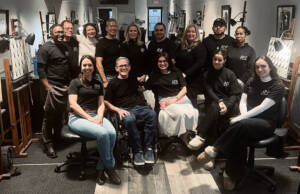
A common question I face when discussing the educational efforts of the ÀNI organization is why the educational focus is visual art. With so many useful academic and vocational programs available today—why choose a visual arts education?
A well-structured visual art education should offer many intrinsic benefits that transcend the parameters of the canvas. A productive skill-based curriculum should utilize a theoretically sound schedule of rationally sequenced activities and experiences to effect development in a host of domains relevant to visual literacy and demonstrably deliberate visual communication. These domains include but are not limited to, visual-spatial skills, visual analysis skills, visual integration skills, fine motor control, automaticity, strategic planning, information synthesis, aesthetics, and procedural fluency.

ÀNI Art Academies Co-Founder Timothy W. Jahn teaching at ÀNI Art Academies Sri-Lanka.
Furthermore, a quality visual arts program should provide an experiential learning environment that effectively nurtures creative and critical thinking development, maximizes retention and comprehension, and fosters a lifelong love of learning and exploration. Learning environments should also include access to all appropriate materials that allow a learner to reach specified learning goals. Resources that provide access to relevant components of art history and diverse artistic traditions should be included. With access to these resources, students can gain insights into different cultures, perspectives, and historical contexts, greatly enhancing their efforts to effectively connect and communicate with a larger audience.
Unfortunately, today, too many institutions fail to identify and study the intrinsic merits of an arts education and instead look to its contributions to other areas of development for validation. A 2007 New York Times article titled “Book Tackles Old Debate: Role of Art in Schools“ addressed the issue by pointing out the long practice of educational institutions justifying the existence or inclusion of art programs by focusing on its contributions to other learning domains instead of the intrinsic values and benefits of artistic activities and education. The article states, “We feel we need to change the conversation about the arts in this country,” said Ms. Winner, a professor of psychology at Boston College and a senior research associate at Project Zero. “These instrumental arguments are going to doom the arts to failure because any superintendent is going to say, ‘If the only reason I’m having art is to improve math, let’s just have more math.’ Do we want to, therefore, say, ‘No singing,’ because singing didn’t lead to spatial improvement?” Ms. Winner added. “You get yourself in a bind there. The arts need to be valued for their own intrinsic reasons.”

ÀNI Art Academies Co-Founder and Curriculum Designer Anthony Waichulis lecturing at Illuxcon
It seems strange that the merits and benefits of artistic development can still be seen today by many as nebulous or elusive as the basic practices, products, and experiences that comprise the arts have been a notable part of the human condition for at least the past 30,000 to 40,000 years. In fact, many regard the classic discoveries of Ice Age European cave art as evidence of the birth of the modern human mind. Even today, children engage in mark-making practices that lay the foundation for complex acts of expression, representation, and communication–essential components of artistic activities–as early as 12-15 months of age. With the demonstrable longevity and relative ubiquitousness of the arts throughout recorded human history, one may find it tempting to think that art is, in fact, some sort of human biological adaptation. This, however, does not seem to be the case. Rather, evidence suggests that visual art emerged as a form of “pleasure technology” created by a relatively clever toolmaking species (us) to appeal to a host of its existing adaptations.
As psychologist and author Steven Pinker writes, humans applied their ingenuity to “create purified, concentrated, supernormal, artificial sources of visual pleasures, just for the sheer enjoyment experienced by both maker and viewer.” Artists combine perceptible cues intended to appeal to our evolved biology in very specific ways. A single artwork may “not only depict a biologically interesting object, person or scene but do so with bold colors, shapes, symmetries, and repetitions, using rare materials and requiring extraordinary craftsmanship. The philosopher Nelson Goodman referred to this feature of compelling art as ‘repleteness.’ In other words, many works of conventional visual art are things we have invented in order to enjoy them.” (Pinker, S. (2016). We Make Art Because We Can. Museum of Old and New Art.)
It is important to note, though, that while sheer pleasure may have inspired and guided the evolution of this human technology, it is safe to say that art has evolved to also serve a host of functions in our society today. From its use to garner intimate insights into our nature to the effective connection and communication it can facilitate across barriers of language, culture, and even time, the arts continue to be of great value to our species. Of such modern functionality, the non-profit Knight Foundation writes, “Art binds. Culture generates social capital and strengthens a community’s character. Art brings people together physically — at galleries, museums, performance spaces — and culturally, through its capacity to tell a community’s shared story, to inspire reflection and form connections that transcend differences.”

ÀNI Founder Tim Reynolds with Students and Colleagues at ÀNI Art Academies America